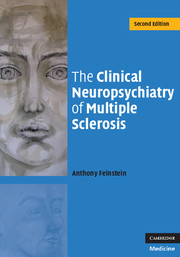Book contents
- Frontmatter
- Contents
- Acknowledgement
- Foreword
- 1 Multiple sclerosis: diagnosis and definitions
- 2 Depression: prevalence, symptoms, diagnosis and clinical correlates
- 3 Depression: etiology and treatment
- 4 Multiple sclerosis, bipolar affective disorder and euphoria
- 5 Multiple sclerosis and pseudobulbar affect
- 6 Multiple sclerosis and psychosis
- 7 Cognitive impairment in multiple sclerosis
- 8 The natural history of cognitive change in multiple sclerosis
- 9 Cognitive impairment in multiple sclerosis: detection, management and significance
- 10 Neuroimaging correlates of cognitive dysfunction
- 11 Multiple sclerosis, disease-modifying treatments and behavioral change
- 12 Multiple sclerosis: a subcortical, white matter dementia?
- Index
- Plate section
- References
6 - Multiple sclerosis and psychosis
Published online by Cambridge University Press: 13 August 2009
- Frontmatter
- Contents
- Acknowledgement
- Foreword
- 1 Multiple sclerosis: diagnosis and definitions
- 2 Depression: prevalence, symptoms, diagnosis and clinical correlates
- 3 Depression: etiology and treatment
- 4 Multiple sclerosis, bipolar affective disorder and euphoria
- 5 Multiple sclerosis and pseudobulbar affect
- 6 Multiple sclerosis and psychosis
- 7 Cognitive impairment in multiple sclerosis
- 8 The natural history of cognitive change in multiple sclerosis
- 9 Cognitive impairment in multiple sclerosis: detection, management and significance
- 10 Neuroimaging correlates of cognitive dysfunction
- 11 Multiple sclerosis, disease-modifying treatments and behavioral change
- 12 Multiple sclerosis: a subcortical, white matter dementia?
- Index
- Plate section
- References
Summary
Introduction
The association between MS and psychosis has until recently been considered uncommon, which helps to explain the paucity of research devoted to the topic. Nevertheless, the relationship is of interest for a number of reasons. These include the possibility that both demyelination and psychosis have a shared, viral pathogenesis, the role of coarse cerebral pathology in the etiology of psychosis, and problems posed by the treatment of psychosis in the neurologically compromised patient.
The DSM-IV diagnosis for psychosis in the context of multiple sclerosis is “psychosis due to a general medical condition” (PDGMC [American Psychiatric Association 1994]; see Table 6.1 for the criteria). The equivalent International Classification of Disease (10th edition; ICD-10; World Health Organization [WHO], 1992) category is one of either “organic hallucinosis,” “organic catatonic disorder,” or “organic delusional (schizophrenia-like) disorder.” This difference in terminology reflects a philosophical divide that separates the taxonomies. Inherent in the DSM approach is the belief that all mental disorders (not just psychotic ones) are “organic” and that the functional–organic dichotomy is needlessly divisive. The ICD-10, mindful of serving a different constituency (i.e. first and third world countries) has retained the word “organic.” Irrespective of which classification is subscribed to, references on both sides of the Atlantic abound in descriptive terms such as “schizophrenia-like,” “secondary psychosis” and “organic psychosis.”
The plethora of terminology also confronts the clinician–researcher with another important dilemma, one that is common to both systems. Is the psychosis caused by the MS or is it a chance occurrence?
- Type
- Chapter
- Information
- The Clinical Neuropsychiatry of Multiple Sclerosis , pp. 99 - 114Publisher: Cambridge University PressPrint publication year: 2007



